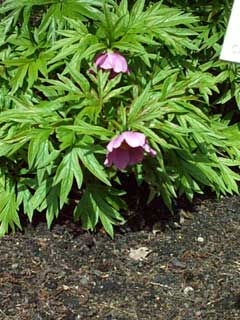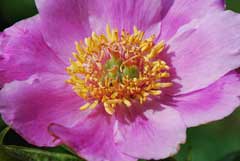 |
|
http://commons.wikimedia.org/wiki/User:Radomil |
 |
|
Translate this page:
Summary
Physical Characteristics

 Paeonia veitchii is a PERENNIAL growing to 0.8 m (2ft 7in) by 0.8 m (2ft 7in).
Paeonia veitchii is a PERENNIAL growing to 0.8 m (2ft 7in) by 0.8 m (2ft 7in).
See above for USDA hardiness. It is hardy to UK zone 8. It is in flower from May to June. The species is hermaphrodite (has both male and female organs) and is pollinated by Insects. The plant is self-fertile.
Suitable for: light (sandy), medium (loamy) and heavy (clay) soils and can grow in heavy clay soil. Suitable pH: mildly acid, neutral and basic (mildly alkaline) soils. It can grow in semi-shade (light woodland) or no shade. It prefers moist soil.
UK Hardiness Map
US Hardiness Map
Synonyms
Plant Habitats
Woodland Garden Sunny Edge; Dappled Shade; Shady Edge;
Edible Uses
References More on Edible Uses
Medicinal Uses
Plants For A Future can not take any responsibility for any adverse effects from the use of plants. Always seek advice from a professional before using a plant medicinally.
Analgesic Antibacterial Antiinflammatory Antispasmodic Diuretic Febrifuge Sedative
The whole root is used in Chinese medicine, its name is Chi Shao Yoa[250]. The root is alterative, analgesic, anodyne, antibacterial, anti-inflammatory, antiseptic, antispasmodic, astringent, carminative, diuretic, emmenagogue, expectorant, febrifuge, hypotensive, nervine and tonic[218, 238]. The most important ingredient medicinally in the root is paeoniflorin, which has been shown to have a strong antispasmodic effect on mammalian intestines, it also reduces blood pressure, reduces body temperature caused by fever and protects against stress ulcers[250]. It is taken internally in the treatment of menstrual disorders, injuries, high blood pressure, pre-menstrual tension and liver disorders[238]. It should only be used under the supervision of a qualified practitioner and should not be prescribed for pregnant women[238]. The roots are harvested in the autumn from cultivated plants that are 4 - 5 years old and are boiled before being dried for later use[238]. The roots of wild plants are harvested in the spring or (preferably) in the autumn and are sun-dried for later use[238]. A tea made from the dried crushed petals of various peony species has been used as a cough remedy, and as a treatment for haemorrhoids and varicose veins[250].
References More on Medicinal Uses
The Bookshop: Edible Plant Books
Our Latest books on Perennial Plants For Food Forests and Permaculture Gardens in paperback or digital formats.

Edible Tropical Plants
Food Forest Plants for Hotter Conditions: 250+ Plants For Tropical Food Forests & Permaculture Gardens.
More

Edible Temperate Plants
Plants for Your Food Forest: 500 Plants for Temperate Food Forests & Permaculture Gardens.
More

More Books
PFAF have eight books available in paperback and digital formats. Browse the shop for more information.
Shop Now
Other Uses
References More on Other Uses
Cultivation details
An easily grown plant, it does best in a deep rich soil, preferably neutral or slightly alkaline[1], doing quite well in sun or light shade[1, 200], and seeming to prefer part shade[233]. Plants are tolerant of a wide range of soil conditions, but will not survive if the soil becomes waterlogged or is too dry[250]. This species is lime tolerant[200]. Plants grown on sandy soils tend to produce more leaves and less flowers, whilst those growing on clay take longer to become established but produce better blooms[250]. Plants are hardy to about -25°c[187]. A very ornamental[1] and long-lived plant, lasting 50 years or more in the garden[200]. This species is closely related to P. anomala, differing mainly in having several flowers to a stem[250]. Members of this genus are rarely if ever troubled by browsing deer or rabbits[233]. A very greedy plant inhibiting the growth of nearby plants, especially legumes[54]. Strongly resents root disturbance, taking some time to recover after being divided[1]. Peony species are usually self-fertile, though they will also hybridise with other species if these flower nearby at the same time[250]. Plants take 4 - 5 years to flower from seed[200]. They generally breed true from seed[1].
References Carbon Farming Information and Carbon Sequestration Information
Temperature Converter
Type a value in the Celsius field to convert the value to Fahrenheit:
Fahrenheit:
The PFAF Bookshop
Plants For A Future have a number of books available in paperback and digital form. Book titles include Edible Plants, Edible Perennials, Edible Trees,Edible Shrubs, Woodland Gardening, and Temperate Food Forest Plants. Our new book is Food Forest Plants For Hotter Conditions (Tropical and Sub-Tropical).
Shop Now
Plant Propagation
Seed - best sown as soon as it is ripe in a cold frame[250]. When sown fresh, the seed produces a root about 6 weeks after sowing with shoots formed in the spring[200]. Stored seed is much slower, it should be sown as soon as possible in a cold frame but may take 18 months or more to germinate[200]. The roots are very sensitive to disturbance, so many growers allow the seedlings to remain in their pots for 2 growing seasons before potting them up. This allows a better root system to develop that is more resilient to disturbance[250]. If following this practice, make sure you sow the seed thinly, and give regular liquid feeds in the growing season to ensure the plants are well fed. We usually prick out the seedlings into individual pots as soon as they are large enough to handle, and then grow them on in a cold frame for at least two growing seasons before planting them out when they are in growth in the spring[K]. Division with great care in spring or autumn. Each portion must have a leaf bud. If the lifted root is stood in shade for several hours it becomes less brittle and easier to divide[200]. Divisions that have several buds will usually flower in the second year, but those that only have one or two buds will take a number of years before they have grown sufficiently to flower[250].
Other Names
If available other names are mentioned here
Native Range
TEMPERATE ASIA: China (Gansu Sheng (c. & s.), Ningxia Huizi Zizhiqu (south), Qinghai Sheng (east), Shaanxi Sheng (south), Shanxi Sheng (north), Sichuan Sheng (west), Xizang Zizhiqu (east), Yunnan Sheng (northeast))
Weed Potential
Right plant wrong place. We are currently updating this section.
Please note that a plant may be invasive in one area but may not in your area so it's worth checking.
Conservation Status
IUCN Red List of Threatened Plants Status :

Growth: S = slow M = medium F = fast. Soil: L = light (sandy) M = medium H = heavy (clay). pH: A = acid N = neutral B = basic (alkaline). Shade: F = full shade S = semi-shade N = no shade. Moisture: D = dry M = Moist We = wet Wa = water.
Now available:
Food Forest Plants for Mediterranean Conditions
350+ Perennial Plants For Mediterranean and Drier Food Forests and Permaculture Gardens.
[Paperback and eBook]
This is the third in Plants For A Future's series of plant guides for food forests tailored to
specific climate zones. Following volumes on temperate and tropical ecosystems, this book focuses
on species suited to Mediterranean conditions—regions with hot, dry summers and cool, wet winters,
often facing the added challenge of climate change.
Read More
Expert comment
Author
Lynch.
Botanical References
200
Links / References
For a list of references used on this page please go here
Readers comment
| Add a comment |
|
If you have important information about this plant that may help other users please add a comment or link below. Only comments or links that are felt to be directly relevant to a plant will be included. If you think a comment/link or information contained on this page is inaccurate or misleading we would welcome your feedback at [email protected]. If you have questions about a plant please use the Forum on this website as we do not have the resources to answer questions ourselves.
* Please note: the comments by website users are not necessarily those held by PFAF and may give misleading or inaccurate information.
To leave a comment please Register or login here All comments need to be approved so will not appear immediately.
|
Subject : Paeonia veitchii
|
|
|
|